As a die-hard Weezer fan and guitarist, achieving the iconic tones of Rivers Cuomo has always been a personal holy grail. Like many musicians, I embarked on a journey to capture that quintessential 90s Weezer guitar sound, specifically for my Weezer tribute band, My Name Is Jonas Brothers. What I discovered was that nailing that sound goes far beyond just playing the right notes – it’s about meticulously recreating every element of Rivers’ legendary guitar setup, starting with his distinctive pickups.
For any guitarist chasing the Weezer “Blue Album” sound, understanding Weezer Rivers Cuomo Guitar Pickups is paramount. It’s a deep dive into the specifics of his famed Blue Stratocaster and the components that contribute to that powerful, yet articulate, guitar tone. This isn’t just about generic rock sounds; it’s about the unique sonic fingerprint that defined a generation of alternative rock.
The Pursuit of Authenticity: More Than Just Good Enough
When we decided to form #weezerquest, our Weezer tribute project, we set one crucial ground rule: authenticity was the ultimate goal. Simply being a “good” Weezer cover band wasn’t enough. We aimed to recreate the sonic landscape of Weezer as faithfully as possible. In a city like Seattle, teeming with talented musicians and even multiple Weezer tribute acts, we knew we needed to stand out by delivering a truly genuine Weezer experience. This meant meticulous research, especially when it came to replicating Rivers Cuomo’s guitar rig.
This pursuit of authenticity led me down a rabbit hole of gear analysis, focusing intensely on the guitars and amplifiers that shaped the early Weezer sound. And at the heart of that sonic signature? The pickups in Rivers Cuomo’s guitars.
Unpacking the Blue Strat: Rivers Cuomo’s Pickup Secret Weapon
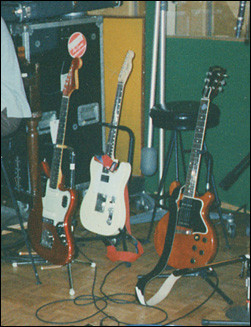 Ric
Ric
Rivers Cuomo’s iconic CAR Jaguar and Les Paul Special DC, key guitars in shaping early Weezer tones. These instruments, along with his Blue Strat, were crucial in developing his signature sound.
Weezer’s signature guitar sound, especially on the “Blue Album,” is often described as a massive wall of guitar tone. Surprisingly, this sonic density wasn’t achieved with typical high-output humbuckers. Instead, Rivers Cuomo relied on the surprising versatility of P90 pickups on Ric Ocasek’s ’59 Les Paul Special DC, famously used on tracks like “Say It Ain’t So.” These P90s, run through Rivers’ Mesa Mark I and Marshall SL-X amps, formed the foundation of that early Weezer power.
However, for my tribute, I wanted to specifically capture the essence of Rivers’ most recognizable guitar: his Blue Stratocaster. This wasn’t a standard off-the-shelf model. Rivers’ Blue Strat, heavily used from 1994 to 2001, was a custom-built instrument, pieced together from Warmoth parts. It was the guitar I most strongly associated with Weezer, the one brandishing the iconic lightning bolt strap, and recreating it became my obsession.
Driven by a desire to replicate this iconic instrument, I embarked on a deep dive to uncover every detail of the Blue Strat. This meant scouring the internet for any visual or written information I could find. Mid-90s interviews, grainy disposable camera photos, and countless blurry screenshots from the “Say It Ain’t So” and “Undone (The Sweater Song)” music videos became my primary research materials. My goal was to meticulously identify each component of this legendary guitar, especially the Weezer rivers cuomo guitar pickups.
The Hundred Acre Woodshed: Delving into the Details
My quest for information quickly escalated. I amassed over 200 reference images of Rivers’ Blue Strat, meticulously cataloging every detail. Unfortunately, concrete information beyond the pickups was scarce, and relying on decades-old, low-resolution images to identify specific parts proved challenging. While the temptation to directly contact Weezer for answers to my nerdy gear questions was strong, I opted to continue my research through available resources.
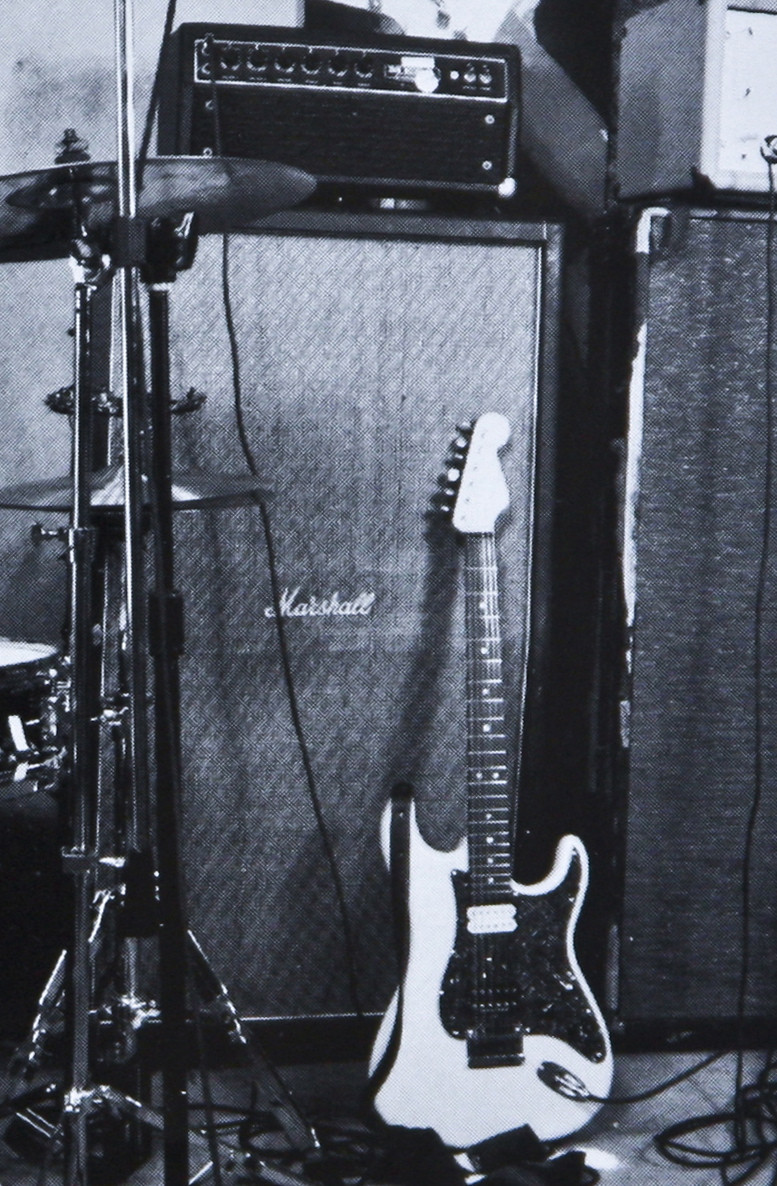 weezer BS EDIT
weezer BS EDIT
Close-up image highlighting details of Rivers Cuomo’s Blue Strat. Analyzing images like this was crucial in identifying components and replicating the guitar’s unique specifications.
Through this intensive visual analysis, it became clear that Rivers’ Blue Strat wasn’t just a random assortment of parts. It appeared to be a deliberate and thoughtful build, tailored to his playing style and addressing perceived limitations of his previous guitars. Whether this was intentional or not remains speculation, but the evidence suggested a methodical approach to his instrument choices.
Fortunately, the dedication of other Weezer enthusiasts, particularly Weezer historian Karl Koch and the comprehensive resource Weezerpedia, proved invaluable. Weezerpedia offered a detailed equipment timeline for each band member, providing a crucial framework for understanding the evolution of Rivers’ gear and specifically his Weezer rivers cuomo guitar pickups.
X-Ray Specs: Pinpointing the Pickups
The visual evidence confirmed the Blue Strat as a hardtail model with a 22-fret rosewood fingerboard and a tortoise shell pickguard. Weezerpedia, however, revealed the crucial information about the Weezer rivers cuomo guitar pickups themselves: a black Seymour Duncan TB-59 Trembucker in the bridge position and a cream DiMarzio Super II in the neck position, both F-spaced. Watching live performances further confirmed a simple electronics setup: a three-way switch, a master volume, and a single tone knob (which, as I later discovered, wasn’t actually a tone knob in the traditional sense).
Other components required more detective work. Tuner identification relied on a combination of limited clear photos and video footage. The shape of the tuner buttons, combined with side views from the “Say It Ain’t So” video, led me to conclude they were Sperzel locking tuners, likely finished in satin chrome due to the lack of reflections.
The control knobs also presented a minor surprise. Initially assumed to be standard volume/tone knobs, closer inspection revealed both were marked “VOLUME.” While I briefly experimented with a dual volume setup, I ultimately opted for a master volume knob sourced from a late 70s Fender Starcaster, a slight deviation from complete authenticity but one I felt added a touch of personal flair.
However, the biggest puzzle revolved around the bridge. Identifying the Weezer rivers cuomo guitar pickups was relatively straightforward compared to deciphering the mystery of the bridge.
Bridge Mystery: The Unsung Hero of Weezer Tone
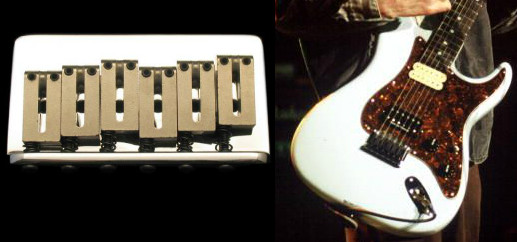 Bridge Comparison
Bridge Comparison
A side-by-side comparison highlighting the unique characteristics of Rivers Cuomo’s Blue Strat bridge. The distinct sustain block and saddle design set it apart from standard hardtail bridges.
While it was clear the Blue Strat featured a hardtail bridge with string ferrules, a closer look revealed a bridge unlike any standard hardtail design. The unusually thick sustain block hinted at a 70s or 80s origin, but clear visuals were elusive. This bridge became an obsession, consuming over ten hours of research time alone.
Exhaustive searches for information about this specific bridge yielded nothing. Turning to Rivers’ known influences, specifically his hair metal background, I began exploring Charvel catalogs from that era. The Jake E. Lee signature model Charvel, with its visually similar bridge, provided a crucial clue. Interviews with Jake E. Lee and further research into Charvel hardware led me to brass hardtail bridges, specifically the Charvel ST111.
Behold, the ST111:
 BrassParts
BrassParts
The Charvel ST111 brass hardtail bridge, identified as the likely model used on Rivers Cuomo’s Blue Strat. Its distinctive sustain block and saddle design were key to unlocking the bridge mystery.
The ST111, particularly the unplated brass version shown in the image, matched the distinctive machined sustain block and elongated saddle design seen on Rivers’ Blue Strat. The bridge mystery was solved!
Finding an original ST111 proved nearly impossible. After countless eBay searches for “brass Strat bridge,” “Charvel Jake E Lee bridge,” and general hardtail bridges, I came up empty. Ultimately, thanks to another Weezer fan, Aaron Pinto, I sourced a Japanese Allparts replica bridge. While not an exact match (slightly narrower string spacing and black plating that wore off), it was visually close and, more importantly, sonically excellent. The quest for the original bridge continues, but the replica served its purpose admirably.
Building a Mystery: Putting It All Together
For other specifications like nut width and fret size, I relied on educated guesses and personal preferences. The goal was to capture the essence of Rivers’ guitar, not necessarily a micrometer-perfect clone.
The resulting Warmoth parts list reflected my research and decisions:
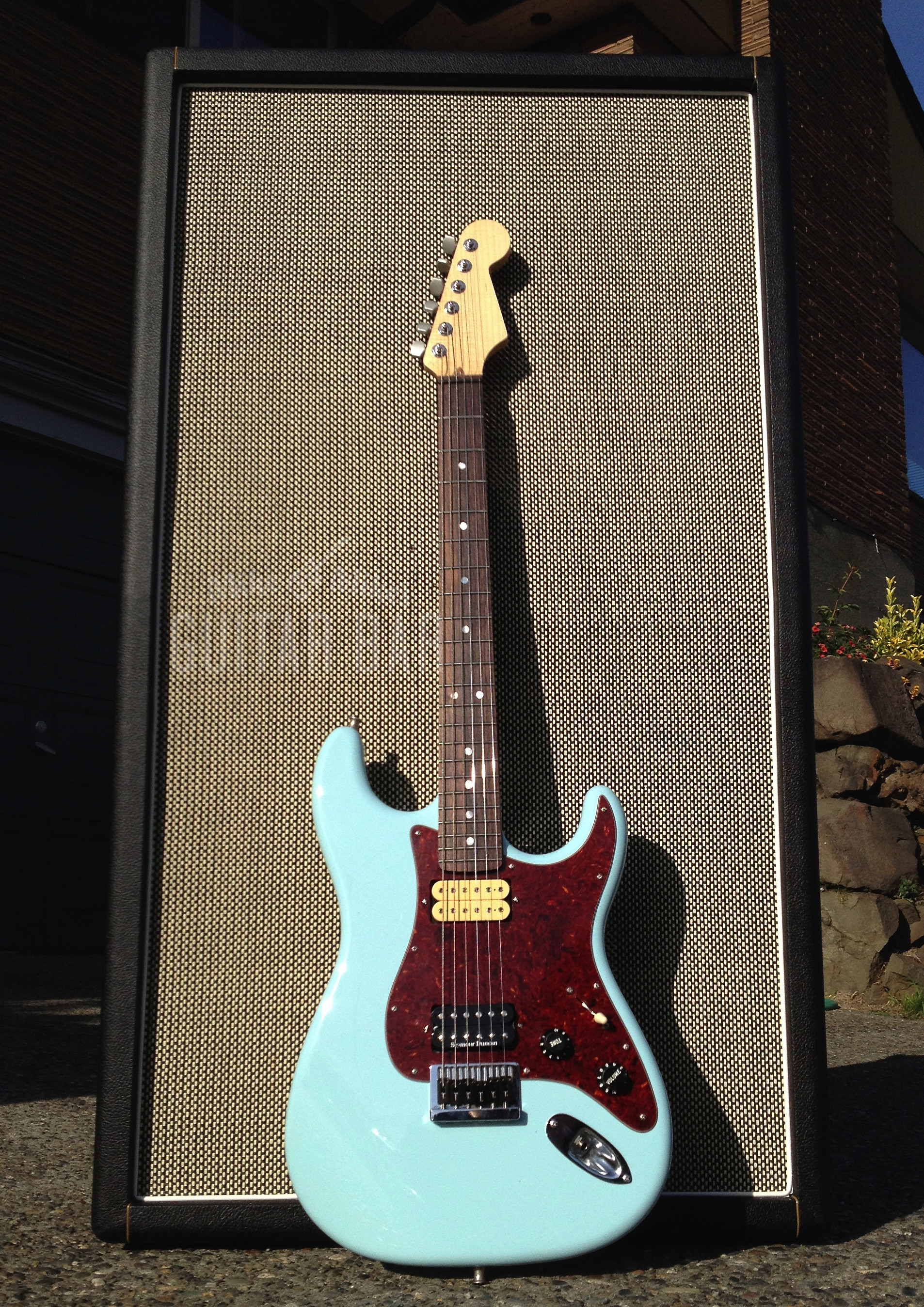 IMG_4844-imp
IMG_4844-imp
Detailed specifications of the Warmoth neck and body components used in the Blue Strat replica build, highlighting key features like the neck profile, fretboard radius, body routing, and finish.
NECK
- Stratocaster profile
- Maple neck wood
- Satin nitro finish
- Rosewood fingerboard
- 1 11/16″ nut width
- 10”-16” compound radius
- 22 frets
- Pearl dot inlays
- Black Corian nut
- Sperzel locking tuners
BODY
- Stratocaster body shape
- 2 Humbucker routing
- Sonic Blue finish
- Hardtail bridge option
- WD Tortoise pickguard
- Reissue Charvel Jake E. Lee style bridge
ELECTRONICS
- Seymour Duncan Trembucker ’59 F-Spaced (8.3kohms) – Bridge
- DiMarzio Super II F-Spaced (8.7kohms) – Neck
- 500k CTS Volume pot
- 250k (275K) tone pot (modified – see “On Thin Ice” section)
- Onboard passive distortion: two 1n34a ‘cat whisker’ diodes in reverse parallel (in place of tone cap)
Warmoth delivered exceptional quality parts. The Sonic Blue finish was spot-on, the satin nitro neck finish was perfect, and the flamed maple neck was a welcome surprise. The neck-body joint was tight and precise, and component installation was seamless. While the pickguard might be slightly too red for perfect accuracy, overall, the parts were remarkably faithful to the original.
Impressions: The Sound of Weezer Realized
Even before plugging in, the guitar felt special. The substantial brass hardtail bridge was immediately noticeable, promising exceptional sustain and resonance. And that bridge, combined with the carefully chosen Weezer rivers cuomo guitar pickups, proved to be the secret to unlocking that classic Weezer sound.
The heavy brass bridge imparted incredible sustain and ring, unlike any Stratocaster I had played before. The tone was characterized by a booming low end, articulate mids, and clear, ringing highs. Even unplugged, strummed chords had a powerful, almost metallic resonance. In Eb tuning, the guitar truly became a beast.
Plugged into a Fender Excelsior Pro amp, the nuances of the Weezer rivers cuomo guitar pickups became even more apparent. Both the DiMarzio Super II (neck, 8.7k) and the Seymour Duncan TB-59 (bridge, 8.3k) pickups were surprisingly moderate in output, especially considering Rivers’ often heavily overdriven tones. Despite the neck pickup being slightly hotter on paper, they balanced perfectly in their respective positions.
In a modern guitar landscape often dominated by high-output pickups, Rivers’ choice of lower-output models for achieving heavy tones is insightful. Overdriving a hot, muddy pickup can result in an even muddier sound. However, pushing a clear, lower-output pickup into overdrive yields a thick, crunchy tone that instantly evokes the classic Weezer sound. Allowing the amplifier to do the heavy lifting emphasizes the guitar’s inherent punch and clarity.
While familiar with the Duncan ’59, the DiMarzio Super II neck pickup was a revelation. Its brightness was unexpected but perfectly suited for the application. Big chords with a low 5th sounded massive, and iconic “Blue Album” solos suddenly had a newfound authenticity. Through my Marshall rig, the guitar unleashed a truly earth-shaking tone.
On Thin Ice: The Secret Tone Mod
As documented on Weezerpedia, Rivers incorporated a Black Ice module into his guitar – a passive overdrive circuit replacing the tone capacitor, designed to emulate tweed amp-like breakup. I initially underestimated the impact of this seemingly small modification on his overall sound.
The original Black Ice module, now redesigned with more gain options, offered a unique tweed-style drive. Intrigued, but initially overwhelmed by wiring complexities of the newer versions, I discovered a simple Instructables guide for building a similar passive overdrive circuit using readily available 1n34a “cat whisker” diodes. Wiring these diodes in reverse parallel in place of the tone cap yielded surprisingly impressive results.
The passive diode circuit added a subtle but crucial layer of grit and warmth to the guitar’s tone, perfectly complementing the Weezer rivers cuomo guitar pickups. When used in conjunction with an overdriven amplifier, it thickened the guitar’s voice and slightly tamed the high-end frequencies, contributing significantly to the authentic Weezer sound. The circuit proved versatile enough to be used in non-Weezer contexts as well, becoming a secret weapon for adding character to my overall guitar tone.
[
View this post on Instagram
](https://www.instagram.com/p/pPz3PrnUcg/?utm_source=ig_embed&utm_campaign=loading)[A post shared by Mike Adams (@puisheen)](https://www.instagram.com/p/pPz3PrnUcg/?utm_source=ig_embed&utm_campaign=loading)
The embedded Instagram post demonstrates the effectiveness of the passive diode overdrive, showcasing its contribution to achieving authentic Weezer-esque tones.
Letterman Jacket: Visual Authenticity
Following our first show, timed with the Blue Album’s 20th anniversary, I decided to further enhance the Blue Strat replica with visual details, specifically the electrical tape designs Rivers used during Weezer’s touring cycles. Karl Koch’s extensive documentation of these tape designs proved invaluable. I chose my favorite – the design seen in the “Say It Ain’t So” video and the 1995 Letterman performance.
Replicating the tape design required careful study of numerous photos and the Letterman performance footage to decipher the tape’s contours around the Stratocaster body. The Letterman performance provided crucial camera angles, revealing the tape’s path around the guitar’s horns. The final result was a visually striking and accurate representation of Rivers’ iconic taped Strat.
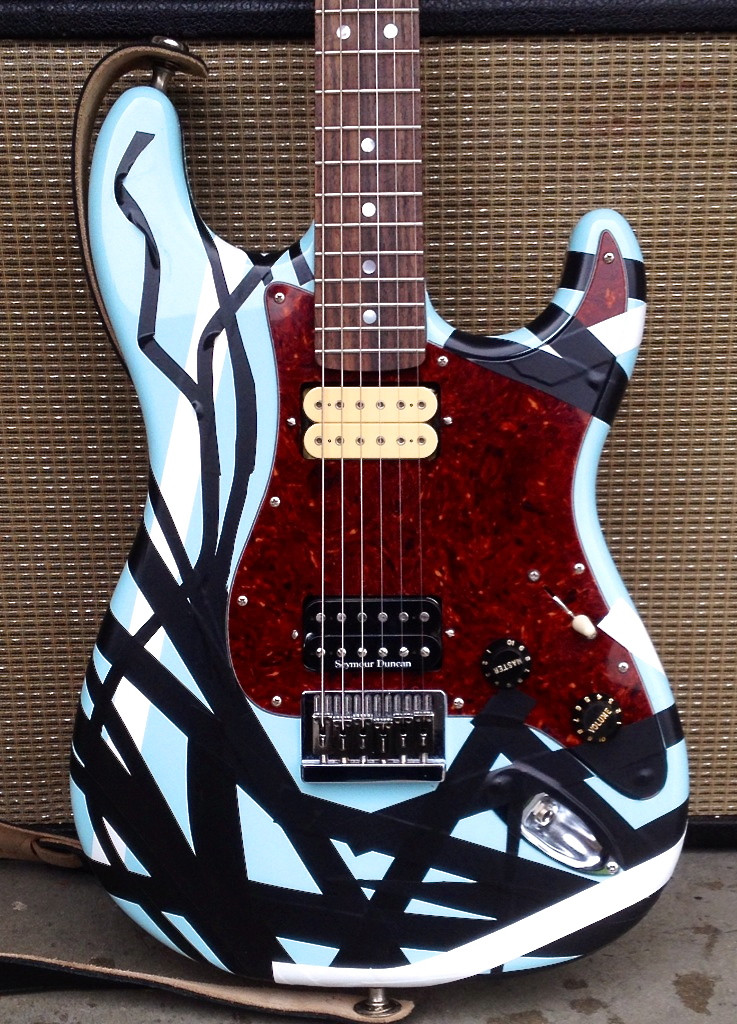 IMG_5940
IMG_5940
The completed Blue Strat replica, showcasing the meticulously applied electrical tape design inspired by Rivers Cuomo’s guitar during the “Say It Ain’t So” era. This visual detail added another layer of authenticity to the tribute project.
AMP RIG: Completing the Weezer Soundscape
While the guitar and Weezer rivers cuomo guitar pickups were crucial, the amp rig was equally important in achieving the complete Weezer sound. Researching Weezer’s amp history revealed two primary amps of significance:
The Mesa Mark I, used extensively for the “Blue Album” era, was sadly lost to time. A Mesa “Son of Boogie” amp briefly entered my possession, capturing a similar early Weezer tone, but my personal preference for British amps led me in a different direction.
For the “Pinkerton” era and 1995 tours, Rivers favored a Marshall 30th Anniversary 6100LM head. This versatile amp, with its multiple channels and modes emulating various classic Marshall tones (JTM45, Superlead Plexi, JCM800/900), became his main amp both live and in the studio until 2001. Interestingly, Rivers’ 6100LM was the 5881/6L6 tube version, often considered less desirable than the EL34 version.
My amp of choice, and a close approximation of the Weezer sound, became my 1979 Marshall 2204 JMP 50-watt. While not directly used by Rivers live, it appeared in studio settings and in Brian Bell’s amp rig, placing it firmly within the right sonic family. It served as a perfect stand-in while searching for the right 6100.
MOCK! YEAH! The Power of the 8×10 Cab
Beyond the amp head, Rivers’ massive “mock 8×10” Marshall cabinet is arguably his true sonic weapon. This custom 1968 Marshall cabinet, sized like an 8×10 but with an offset 4×12 baffle and a mix of Celestion blackback and greenback speakers, moves an immense amount of air, contributing significantly to the Weezer wall of sound.
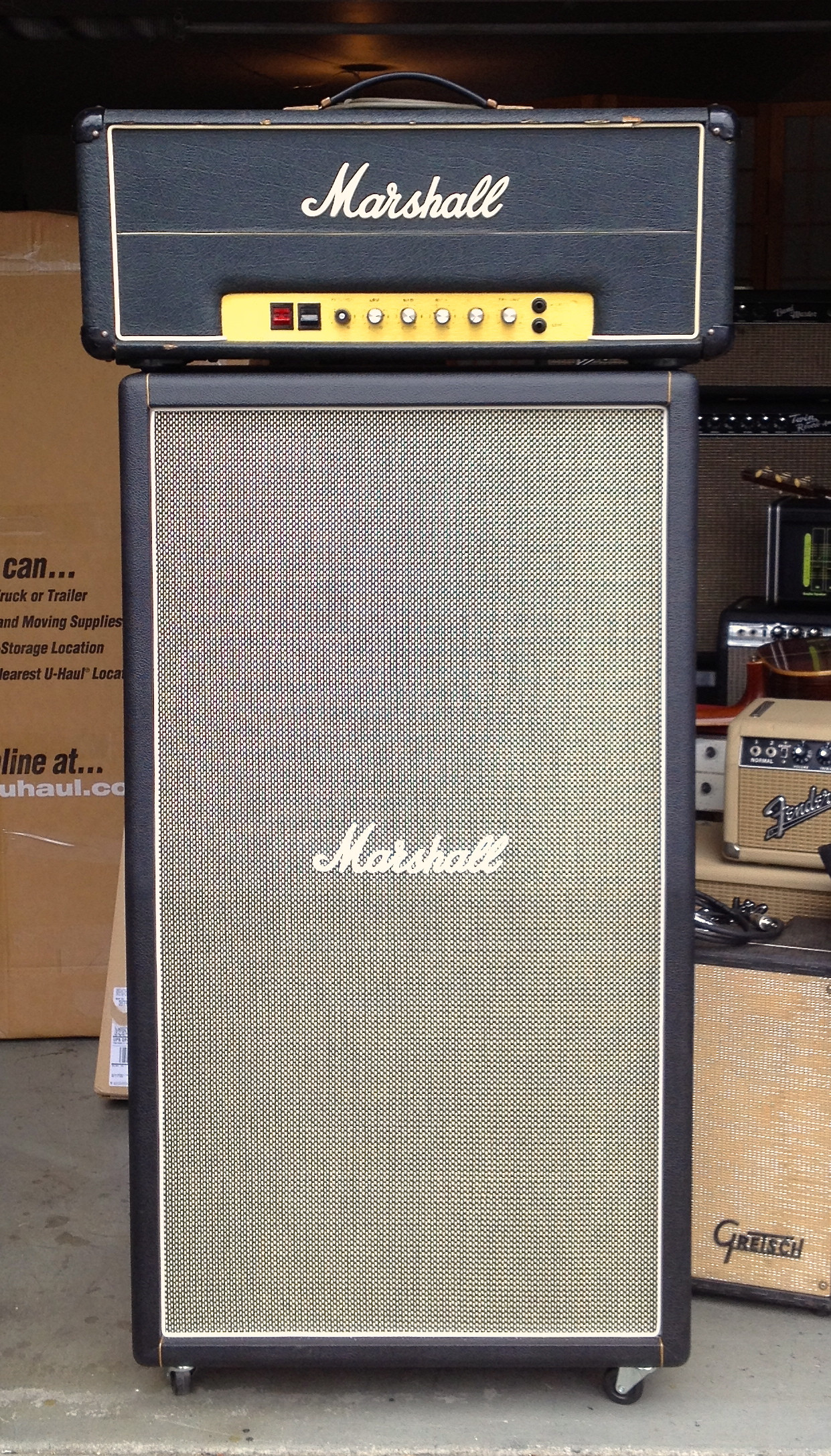 I installed a medium Marshall logo to match my head, but it
I installed a medium Marshall logo to match my head, but it
The custom-built “mock 8×10” Marshall cabinet replica, a key element in replicating Rivers Cuomo’s powerful stage presence and massive guitar tone. The sheer size and speaker configuration of this cabinet contribute significantly to the Weezer sound.
Unable to locate an original ’68 8×10/4×12, I commissioned a custom replica from Sourmash Guitar Cabs. They expertly recreated the 1990 cabinet, and the sonic impact was immediate. The sheer size of the cabinet translated to immense sonic power. Loaded with the same speaker configuration as Rivers’ cabinet and paired with my 50-watt Marshall head, the rig became thunderous and massive – my favorite cabinet to date.
The imposing setup, both visually and sonically, often surprised sound engineers. Initial skepticism often turned into impressed approval after hearing the rig in action.
PEDALS: Less is More for Weezer Tone
For this Weezer project, my typically extensive pedalboard was pared down significantly. A modified BOSS DS-1 (diode removed for volume boost) served as a lead boost. Beyond a tuner, the only other pedal in the My Name Is Jonas Brothers rig was a Z.Vex Fuzz Factory, used to capture the fuzz-laden sounds of “Pinkerton” tracks like “Pink Triangle” and “The Good Life.”
This minimalist pedal approach, combined with the carefully replicated guitar, Weezer rivers cuomo guitar pickups, and amp rig, proved to be the key to unlocking the authentic Weezer sound.
This deep dive into Rivers Cuomo’s gear, particularly the Weezer rivers cuomo guitar pickups and his unique bridge choice, was essential in capturing the genuine Weezer tone for my tribute band. It’s a testament to the fact that achieving iconic guitar sounds often lies in the meticulous details and a deep understanding of the artist’s sonic choices.
Stay tuned for a tour of the rigs of the other members of My Name Is Jonas Brothers, as we continue our quest for Weezer authenticity!
Like My Name Is Jonas Brothers on Facebook for show updates and pictures. And be sure to check out Weezer’s latest record, Everything Will Be Alright In The End. It’s truly excellent.
